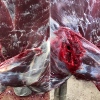Light game -- as in lightweight, CXP2, medium-sized game, like small deer, goats, sheep, pigs, antelope, light black bears, under 300 pounds.
I think medium bore rifle cartridges like the .338 Winchester Magnum, .35 Whelen and .375 H&H Magnum are most commonly associated with heavier big game like moose, elk, caribou, the great bears, and African plains game, and subsequently, the cartridges are most often loaded with heavy bullets of sturdy construction.
But medium-bore rifles could offer excellent performance on lightweight medium game if the bullets were appropriate. Compared to big-bore light game cartridges like .450 Bushmaster, .444 Marlin, .45-70, .460 S&W Magnum and many of the big-bore handgun cartridges, a medium-bore rifle cartridge offers a better trajectory and greater reach due to higher velocities and greater ballistic coefficients.
There are some old medium-bore lever-action cartridges that I do not think offer these advantages like the 35 Remington, which produces low-velocity and is typically loaded with heavy bullets with a poor ballistic coefficient due to the tubular magazines.
So, are the bullets out there to load medium bore cartrdiges like .338 Federal, .358 Winchester, or .375 H&H for game as light as pronghorn?






